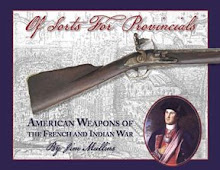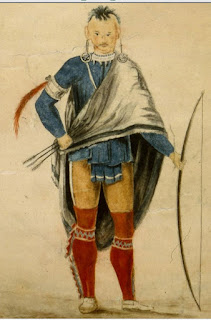Reverend David Jones 1773
"I WOULD dismiss the subject about these Indians, only it will be expected that some description of their apparel should be given* In this respect they differ nothing from most of other Indians. ...The men wear shirts, match-coats, breechclouts, leggings and mockesons, called by them mockeetha. Their ornaments are silver plates about their arms, above and below their elbows. Nose jewels are common.
They paint their faces, and cut the rim of their ears, so as to stretch them very large. Their head is dressed in the best mode, with a black silk handkerchief about it; or else the head is all shaved only
the crown, which is left for the scalp. The hair in it has a swan's plume, or some trinket of silver tied in it. The women wear short shifts over their stroud, which serves for a petticoat. Sometimes a calico bed-gown.
Their hair is parted and tied behind. They paint only in spots in common on their cheeks. Their ears are never cut, but some have ten silver rings in them. One squaa will wear five hundred silver broaches stuck in her shift, stroud and leggings. Men and Women are very proud, but men seem to exceed in this vice.'Tis said that they suffer no hair to grow on their body, only on their head. Some pull out their eyebrows."
A Shawnee/Savanah.war party were captured in South Carolina in 1753. When interrogated by the Governor Glen, the common use of feathers in their hair was suggested:
"-Governor (to the Interpreter). Ask if this Feather belongs to him?
-PRISONER. We wear it as an Ornament on our Heads . All our Indians dress the same Way"
Swan's plumes are mentioned above by Jones, a black Ostrich plume was mentioned by Rideout in 1788. A variety of colors of Ostrich plumes were imported from Africa for both the Indian trade and millinery.
-Virginia Gazette, Purdie and Dixon, October 14, 1773, page 2 "Ladies
fashionable Riding Hats, with black, blue, and white Ostrich feathers
for them..."
-Virginia Gazette, Rind, May 12, 1774, page 3 "blue, black, and white ostrich feathers..."
-History of the Maumee River basin ..." By Charles Elihu Slocum p150: Detroit for the year ending 20th August, 1783, before the treaty of peace, viz : 230 pieces Blue strouds; 20pieces Red strouds;...300 large feathers, red, blue, green ; 300 Black ostrich feathers..."
Nicholas Cresswell 1774
"Wednesday, December 7th, 1774. Went to Winchester...Saw four Indian Chiefs of the Shawnee Nation, who have been at War with the Virginians this summer, but have made peace with them, and they are sending these people to Williamsburg as hostages. They are tall, manly, well-shaped men, of a Copper colour with black hair, quick piercing eyes, and good features. They have rings of silver in their nose and bobs to them which hang over their upper lip. Their ears are cut from the tips two
thirds of the way round and the piece extended with brass wire till it touches their shoulders, in this part they hang a thin silver plate, wrought in flourishes about three inches diameter, with plates of silver round their arms and in the hair, which is all cut off except a long lock on the top of the head. They are in white men's dress, except breeches which they refuse to wear, instead of which they have a girdle round them with a piece of cloth drawn through their legs and turned over the girdle, and appears like a short apron before and behind. All the hair is pulled from their eyebrows and eyelashes and their faces painted in different parts with Vermilion. They walk remarkably straight and cut a grotesque appearance in this mixed dress. "
When David Jones wrote that "some description of their apparel should be given* In this respect they differ nothing from most of other Indians..." he drove home the point that speaking broadly, Indian consumers from Georgia to Maine purchased and were given many of the same types of goods, and as Edmund Atkin noted in 1755, the Shawnee were "the greatest Travellers in America".
Goods fit for a Present to the Six Nations. 1752 (Virginia House of Burgesses)
"...Goods fit for a Present for the Six United Nations together with the Shawanse, Delawares, Twigtwees, Picts and Windotts
Strouds...Duffils....Halfthicks....Garlix (to be made into plain shirts for men...to be made into shirts for men, ruffled with Muslin...flints...Gartering and Bedlace, the gartering scarlet and Star...Ribbon, deep red, blew, and green...Striped Callimancoe lively colours, Mens's large worsted caps...cuttoe knives...100 Guns, small bored, and 25 pr pistols... 5 doz. Cutlasses...square Indian Awl Blades, Brass kettles...wire..Beads small white...50 Meddals with His Majesty's picture on one side and the British Coat of Arms on the other...with a loop to put a ribbon through...Whatever quantity of Lace Cloths and Hats and Feathers shall be thought proper, I imagin that scarlet cloth cuff'd and lapell'd with blew, laced with common single lace would be acceptable as any."
Fort Johnson 25 Janr?. 1757.
The Papers of Sir William Johnson, Volume 9 p592
Another Belt to the Shawanese King returning him thanks for the early Intelligence he sent me and desiring he would constantly accquaint him of the Enemies Motions in that part of the Country, also exhorting him & his Nation to adhere firmly to the Treaties & Friendship subsisting between them & the English which they would find to be their Interest & with all giving them a hearty Invitation to come & join His Majestys Arms when called upon. Sr. Wm. gave the Messenger 10 Dollars, a fine Scarlet Blanket with several Rows of Ribband on it, a fine Ruffled Shirt a Silver Arm Band for the Kings Son — Pipes, Tobacco, Powder & Ball & a pair of Snow Shoes — so parted
p649
1757 Janry Brought over
To an Express sent to me by the Shawanese King with News of a Body of French and Indians coming from Mississippy...4/-/-
To a Do. a Scarlet Strowd with Ribbons to it...3/-/-
Thomas Rideout An Account of my Capture by the Shawnee Indians on the River Ohio in 1788
"My Dress consisted of a calico shirt, made by an Indian woman without a collar, which reached below the waist; a blanket over my shoulders, tied round the waist with the bark of a tree; a pair of good buckskin leggings, which covered almost the thighs, given me by the great war chief, a pair of moccasins, in which I had pieces of blue cloth to make my step easier; a breech-cloth between my legs; a girdle round my waist; and a small round hat, in which the Indian placed a black ostrich feather by way of ornament (the smaller the hat the more fashionable)."
The 1922 Guide to the Heye Foundation Museum of the American Indian includes a reference to a pair of "Shawnee Deerskin Leggings" but I have not been able to find images or a current location for this item.
Tecumseh's Headdress ( no later than 1813)
In addition to trade lists with French and English "trade" guns, a few indications of the types of weapons used by 18th century Shawnee warriors can be found in primary sources and through archaeology.
Col. John Bradstreet, December 4, 1764
"from the Governt of Pennsylvania all the Shawnees and Delawar Indians are furnished with rifle barrel Guns, of an excellent kind, and that the upper Nations are getting into them fast..." (p77 British Military Flintlock Rifles, 1740-1840; De Witt Bailey)
Shawnee town of Wakatomika (1st village of that name which was destroyed in August of 1774) goods including a possible limestone "Micmac" pipe bowl and what is likely a French trade fusil lock and rammer pipe from Dresden Ohio.
War Party Plunder from the Battle of Point Pleasant 1774
"* * * told that of 430 Shawnese Warriors or upwards that came out, only 200 had returned, as they were Assisted by the Mingoes, Tawas & Wiandots. and perhaps had several Delawares with them, it confirmed the Judgement we formd £ found to be 23 Guns 80 Blankets 27 Tomahawks with Match coats Skins Shout [shot] pouches pow[d]erhorns Warclubs &c. The Tomhawks Guns & Shout pouches were sold & amounted to near 100 1..."
Amateur Archeologist Greg Shipley's Shawnee artifacts portions are from pre-1787 contexts at McKee's Town, Wapatomica [2nd] and Moluntha's Town.
Techumseh's Galloway pipe Tomahawk ca. 1795
Tecumseh's Adena pipe tomahawk ca 1807
Techumseh's Bow ca. 1812
Proctor Techumseh pipe tomahawk ca 1812
Russell Techumseh pipe tomahawk ca 1812
Techumseh's Powder horn ca. 1813
Pipe Tomahawk with Shawnee attribution (acquired in 1882 via Kansas) from the British Museum
Pipe bowl and gun parts from Wakatomika
Prisoner: This Belt I had it made for myself, and bought it that if I took any Prisoners and tied him, I might put it round his Neck. .
Governor [Glen]: (taking up a .Ligament of a black Colour made up of Buffalo's Wool) . What is the Use of this?
Prisoner: It is to tie my Prisoners with.
Possible Shawnee Figural Pipe
Tecumseh's Headdress (no later than 1813)









